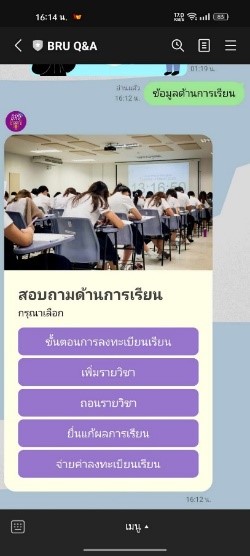The Development of Chatbot Application for Student Services: A Case Study of Buriram Rajabhat University
Keywords:
Application, Chatbot, Student ServicesAbstract
This research aims to develop a chatbot application for student service and study user satisfaction with the application. This is to facilitate quick responses to questions, provide information, and assist students with learning-related issues at the university without time and location constraints on service delivery. Additionally, it can reduce the workload of staff in answering questions. The sample group consists of 385 students from Buriram Rajabhat University. Research tools include an online questionnaire to collect questions that students need answers to at the university and a satisfaction survey on application usage. The statistical analysis used in the research includes percentages, averages, and standard deviations. The development process of the application follows the system development life cycle, which involves gathering questions that students need answers to and designing a database to store them in MySQL. The development tools used include LINE Bot Designer, Dialogflow, PHP, and Laravel Framework.
The study found that the chatbot application for student services, operating within the LINE application, can address queries across 8 domains of student services: course registration, course enrollment and withdrawal, tuition payment, grade appeals, academic calendars, activity calendars, student welfare funds, and university building locations. There is also a web application to manage chatbot responses, allowing staff to conveniently add, delete, and modify responses within the database. The study results of user satisfaction with the application's usage found that there was a high level (= 4.42, S.D = 0.65).
References
กองพัฒนานักศึกษา มหาวิทยาลัยราชภัฏบุรีรัมย์. (2564). รายงานการประเมินตนเอง (Self Assessment Report: SAR) ประจำปีการศึกษา 2564. บุรีรัมย์: มหาวิทยาลัยราชภัฏบุรีรัมย์.
เกสรา เพชรกระจ่าง, อรรถพล คงหวาน, ปิยะพร มูลทองชุน, นงนาฏ ระวังวงศ์ และพงศกร เจริญเนตรกุล. (2567). ระบบการนัดหมายและสื่อสารสำหรับสถานพยาบาลด้วยแชตบอต. วารสารวิชาการเพื่อการพัฒนานวัตกรรมเชิงพื้นที่, 5(1), 34-46.
เกียรติพันธ์ศักดิ์ บิลอับดุลล่าห์. (2564). การประยุกต์ใช้ Chatbot สนับสนุนงานสอบสวน กรณีศึกษาสถานีตำรวจภูธรเบตง. สารนิพนธ์หลักสูตรวิทยาศาสตรมหาบัณฑิต สาขาวิชาการจัดการเทคโนโลยีสารสนเทศ. สงขลา: มหาวิทยาลัยสงขลานครินทร์.
จิตราภา กุณฑลบุตร. (2550). การวิจัยสำหรับนักวิจัยรุ่นใหม่. กรุงเทพฯ: บริษัทสหธรรมิก จำกัด.
เจนนิสา ยศอินทร์ และวีรอร อุดมพันธ์. (2565). การพัฒนาระบบแชทบอทเพื่อการประชาสัมพันธ์หลักสูตรแบบอัตโนมัติ กรณีศึกษาโปรแกรมวิชาวิทยาการสารสนเทศ คณะวิทยาศาสตร์และเทคโนโลยี มหาวิทยาลัยราชภัฏนครราชสีมา. วารสารวิจัยวิทยาศาสตร์และเทคโนโลยี มหาวิทยาลัยราชภัฏนครราชสีมา, 7(1), 74-84.
ทิพย์วรรณ ฟูเฟื่อง อนุสรณ์ เจริญนาน วันดี โชคช่วยพัฒนากิจ พงศ์ปณต ทองงาม และเรเน่ ชมิทท์. (2564). การพัฒนาแชตบอตให้ความรู้ด้านดิจิทัลสำหรับนักศึกษาระดับปริญญาตรี. การประชุมวิชาการเสนอผลงานวิจัยระดับชาติด้านวิทยาศาสตร์และเทคโนโลยี มหาวิทยาลัยราชภัฏจันทรเกษม ครั้งที่ 4 คณะวิทยาศาสตร์ มหาวิทยาลัยราชภัฏจันทรเกษม, 28-38.
ธนากร อุยพานิชย์ และกอบแก้ว มีเพียร. (2565). การพัฒนาแชทบอทเพื่อบริการกองทุนเงินให้กู้ยืมเพื่อการศึกษา. วารสารวิทยาการสารสนเทศและเทคโนโลยี, 3(1), 65-76.
บุญชม ศรีสะอาด. (2560). การวิจัยเบื้องต้น พิมพ์ครั้งที่ 10. กรุงเทพฯ: สุวีริยาสาส์น.
มหาวิทยาลัยราชภัฏบุรีรัมย์. (2566). รายงานประจำปี มหาวิทยาลัยราชภัฏบุรีรัมย์. บุรีรัมย์: กองนโยบายและแผน มหาวิทยาลัยราชภัฏบุรีรัมย์.
รัตนาวลี ไม้สัก และจิราวรรณ แก้วจินดา. (2563). แอปพลิเคชันแชตบอตเพื่อการส่งเสริมการท่องเที่ยวเชิงเกษตรและวัฒนธรรม. รายงานการวิจัยคณะบริหารธุรกิจ มหาวิทยาลัยเทคโนโลยีราชมงคลพระนคร. กรุงเทพฯ: มหาวิทยาลัยเทคโนโลยีราชมงคลพระนคร.
Abeer Alabbas & Khalid Alomar. (2024). Tayseer: A Novel AI-Powered Arabic Chatbot Framework for Technical and Vocational Student Helpdesk Services and Enhancing Student Interactions. Applied Sciences, 14(6). Retrieved from https://www.mdpi.com/2076-3417/14/6/2547.
Andrew Burgess. (2018). The Executive Guide to Artificial Intelligence. Cham, Switzerland: Springer.
Bayan Abu Shawar & Eric Atwell. (2007). Chatbots: Are they Really Useful? Journal for Language Technology and Computational Linguistics, 22(1), 29-49.
Chiara Valentina Misischia, Flora Poecze , & Christine Strauss. (2022). Chatbots in customer service: Their relevance and impact on service quality. Procedia Computer Science, 201, 421-428.
Ellis Pratt. (2017). Artificial Intelligence and Chatbots in Technical Communication – A Primer. Retrieved from https://intelligent-information.blog/wp-content/uploads/2017/09/A-Primer-AI-and-Chatbots-in-Technical-Communication.pdf.
Inbenta. (2016). The Ultimate Guide to Chatbots for Business. Retrieved from https://sjstransky.writerfolio.com/attachments/81067.pdf.
LINE Developers. (2020). Building LINE Chatbot using Dialogflow. Retrieved from https://codelab.line.me/codelabs/chatbot/index.html#0.
Sumana Budsabok, Nattaporn Pechpong, & Chiranut Singtokaeo. (2020). Development of Chatbot Application for Student Services Case Study: Division of Student Development Rajamangala University of Technology Suvarnabhumi. Journal of Applied Research on Science and Technology (JARST), 19(2), 85-94. Retrieved from https://ph01.tci-thaijo.org/index.php/rmutt-journal/article/view/240597.





